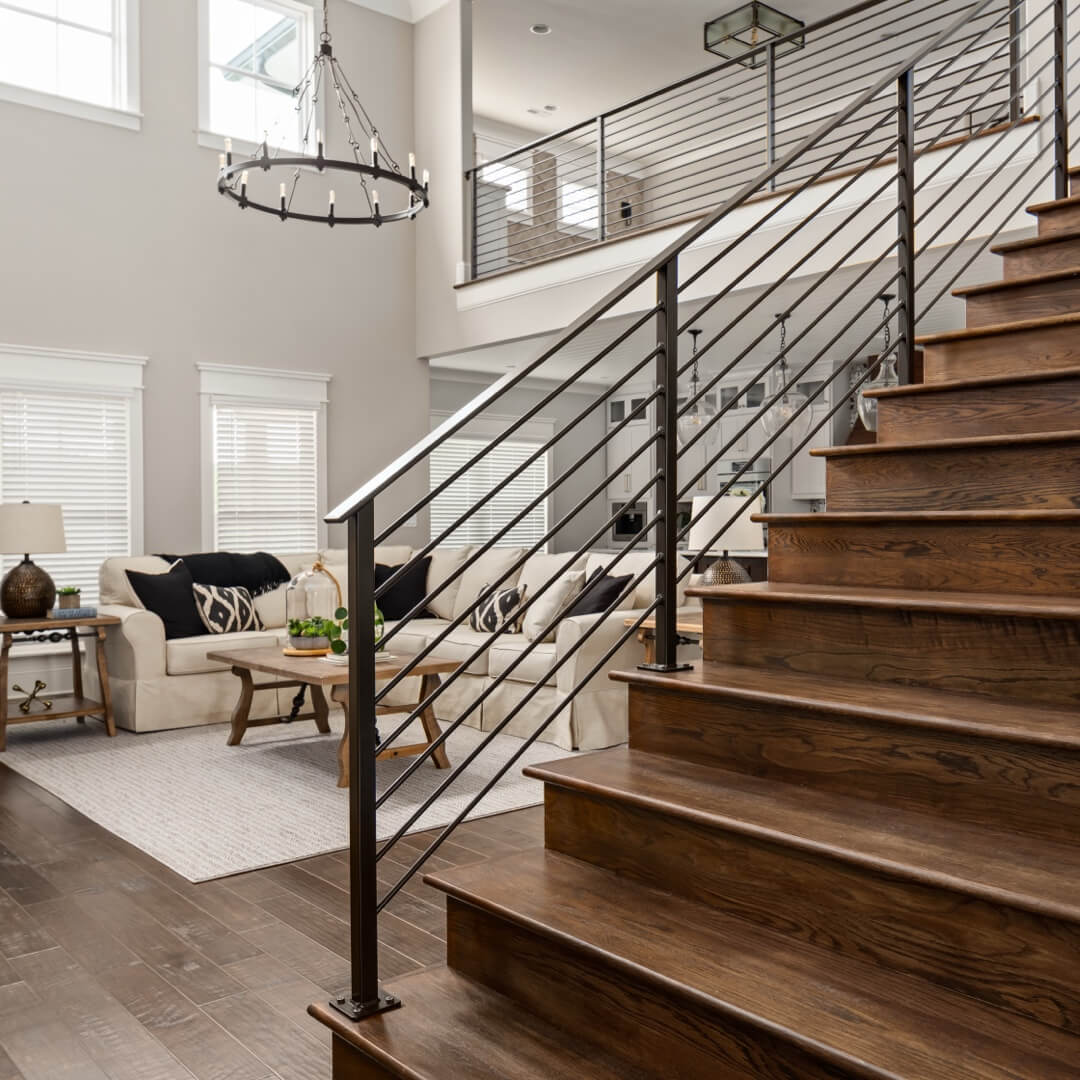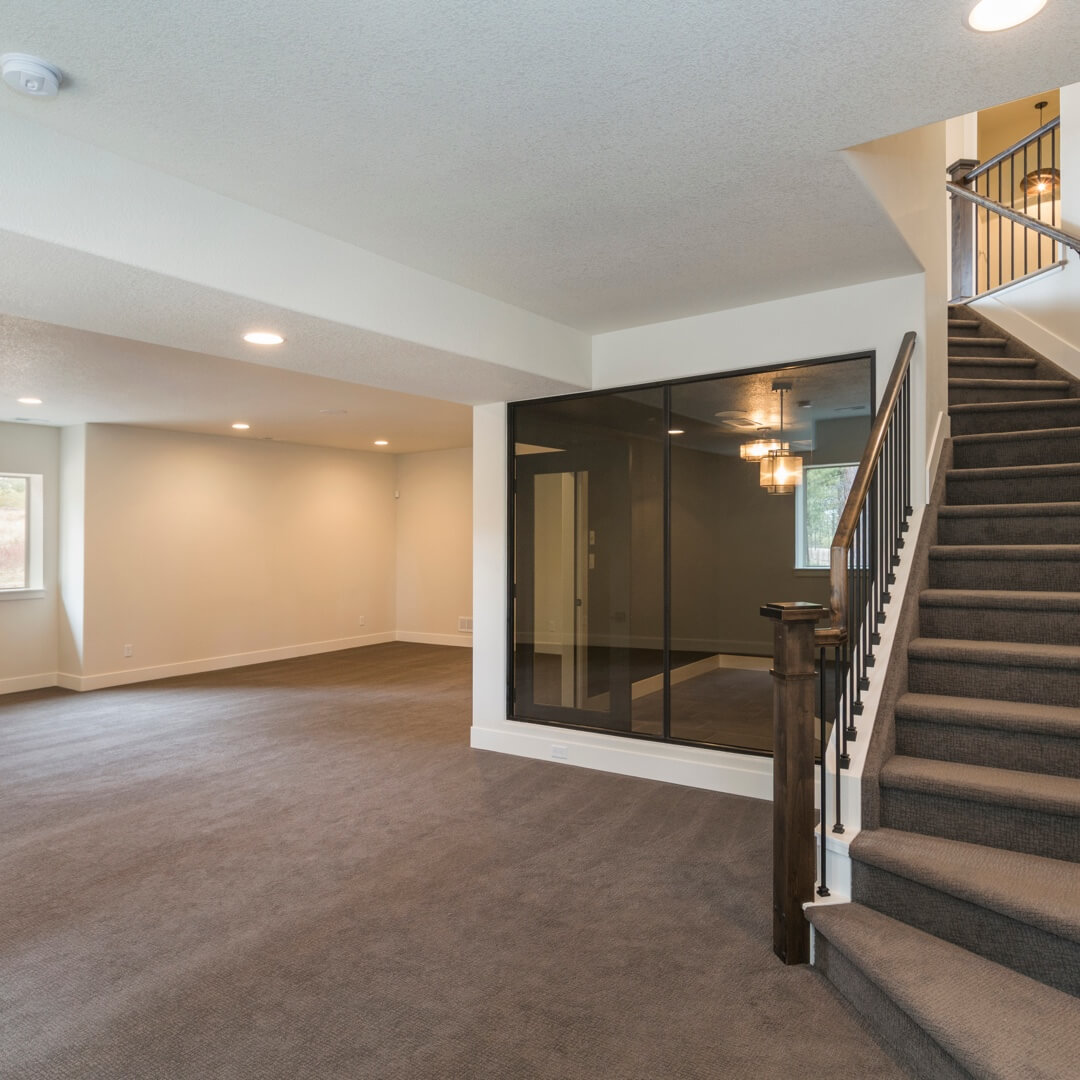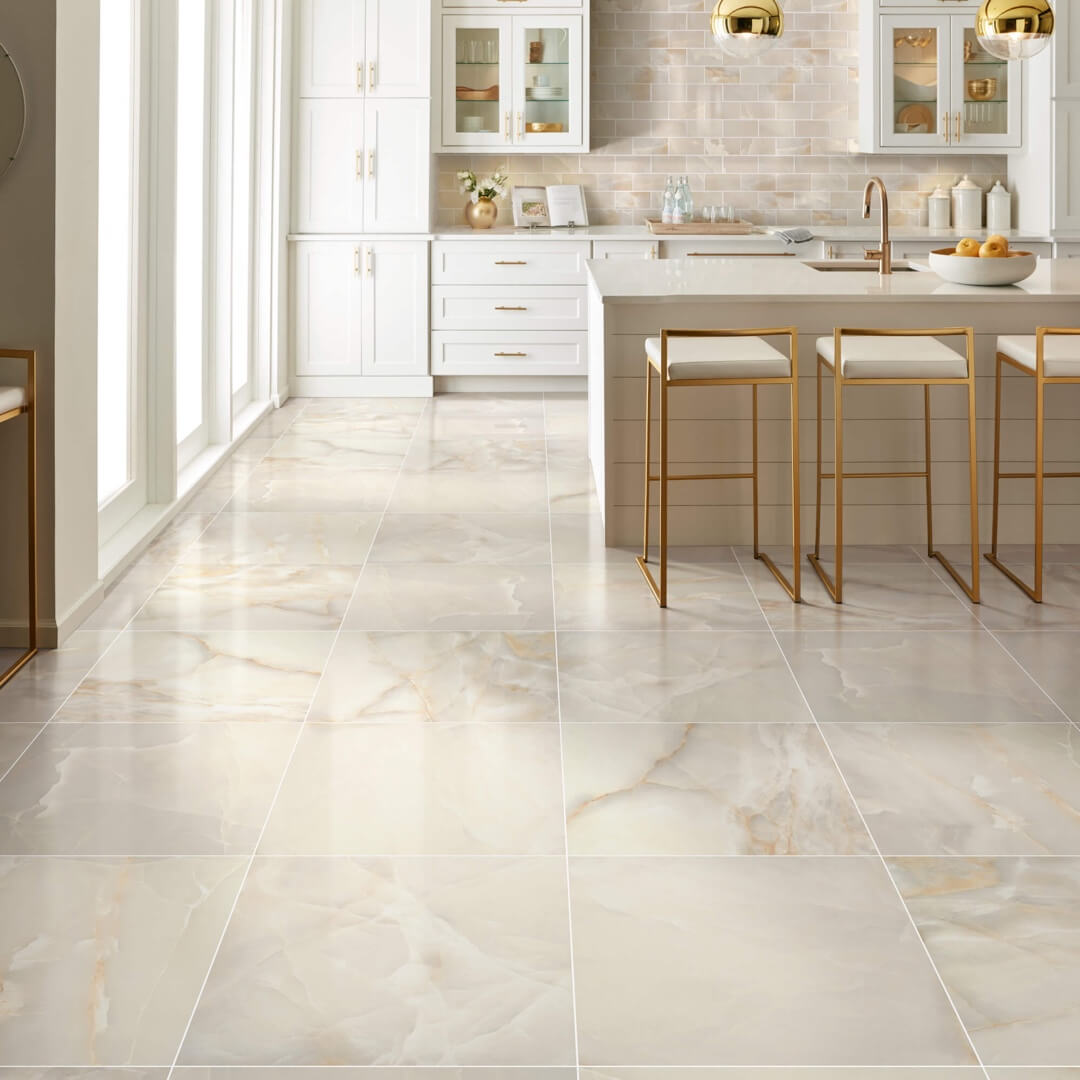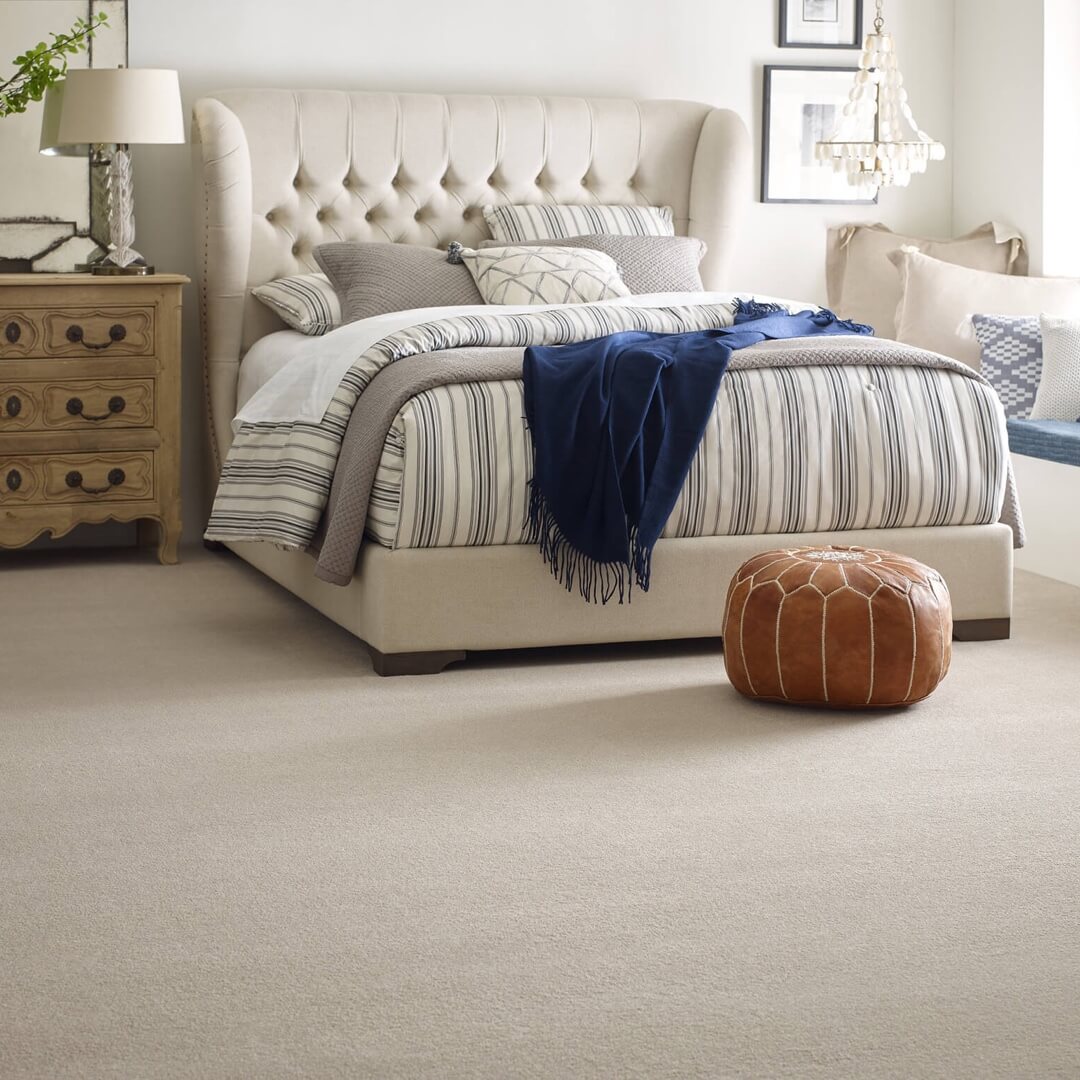Considerations for Flooring Throughout a Multi-Story House
Choosing flooring for a multi-level home presents a unique set of challenges.
Each level has its own function, conditions, and usage. What works well for a quiet bedroom is not ideal for a high-traffic kitchen or a damp basement.
That’s why it’s important to look at your flooring plan as a whole, selecting surfaces that complement one another visually while meeting the practical needs of each space.

From sound control to structural concerns, the right flooring plan supports comfort, design continuity, and long-term durability across your entire home.
Key Considerations for Multi-Story Flooring
Anytime you’re choosing new flooring for your home, you’ll want to take into consideration the room usage, your lifestyle, and of course, your personal style. But when you’re selecting flooring across multiple stories, you’ll also want to pay special attention to how your flooring affects acoustics, temperature, and functionality.
It’s important to weigh how each surface will perform in its specific environment and how it contributes to your entire home.
Acoustic Performance
In a multi-story home, noise doesn’t stay put. Sounds from footsteps, conversations, televisions, or pets can easily carry between levels, especially when hard surfaces are involved. Choosing the right flooring, along with proper sound insulation, can make a noticeable difference in comfort and quiet.
Consider the following ways your flooring choices can help control sound:
- Carpet and other soft surfaces naturally absorb sound, making them a strong choice for upstairs bedrooms, hallways, or playrooms.
- Hard surfaces like wood or tile tend to reflect sound but pairing them with a quality underlayment can reduce footfall noise and echo.
- Sound-dampening underlayment is especially valuable on upper floors, helping to minimize noise transfer to the rooms below.
Structural & Subfloor Requirements
Before selecting flooring for any level of your home, it’s important to understand the role your subfloor plays. The subfloor affects not only how the flooring feels underfoot, but also how it performs over time, especially when weight or moisture is a factor.
Keep these subfloor and structural details in mind:
- Heavy materials like tile or stone may not be suitable for second floors without reinforced support underneath.
- A smooth, level subfloor is essential for all flooring types. Even slight irregularities can lead to visible imperfections, movement, or premature wear.
- Moisture-prone areas like basements require moisture-resistant flooring and underlayment to protect the subfloor and ensure longevity.
Functionality & Lifestyle by Level
Not all floors of your home serve the same purpose, so your flooring shouldn’t either. Choosing materials based on how each level is used helps create a home that supports your daily routines and activities.
Think about the primary use of each story:
- Basements often serve as utility zones, storage, or casual living spaces. Durability and moisture protection are key.
- Main floors experience the most foot traffic and activity, especially around kitchens, entryways, and living areas.
- Upper levels tend to be quieter and more private. Comfort underfoot and sound absorption matter most in bedrooms and bathrooms.
Aesthetic Flow & Visual Continuity
Flooring plays a defining role in your home’s design. The way materials flow from one level to another can either create harmony or feel disjointed.
Consider the following design factors:
- Using the same flooring in high-traffic areas can make spaces feel larger and more connected.
- Transitioning between materials should feel intentional. Floor trim, thresholds, and layout choices help ensure a clean, coordinated look.
- Lighting conditions vary between floors. The same flooring can appear different upstairs versus downstairs, so factor in natural and artificial lighting when selecting color and texture.
Staircase & Landing Integration
Staircases and landings create visual continuity throughout your home. The right materials can add beauty, safety, and functionality to these highly used areas.
When choosing flooring for stairs and landings:
- Prioritize traction and durability to keep your staircase safe and resilient.
- Matching the main level flooring creates a seamless look, while stair runners or complementary materials can add texture and interest.
- Materials should balance form and function, since stairs play a key role in the structure and style of your home.
How to Choose Flooring for Each Level of Your Home
When planning flooring across multiple levels, there’s no need to use the same material everywhere. In fact, the best results often come from choosing materials that suit each floor’s structure, usage, and design context. A thoughtful approach ensures your home is both functional and visually unified, from the basement to the top floor.
Basement Solutions
Basements tend to present the most challenging flooring conditions. Because they’re typically below grade, they’re more likely to be exposed to moisture, temperature swings, and concrete subfloors. Materials used here need to be resilient, practical, and appropriate for the type of space, whether finished or unfinished.
Smart choices for basement flooring include:
- Luxury Vinyl (LVP/LVT): This waterproof, durable material is a go-to for finished basements. It resists moisture, adds insulation, and mimics the look of hardwood or tile without the vulnerabilities.
- Tile or Natural Stone: A strong choice for laundry areas, storage rooms, or utility zones. Tile is highly water-resistant and easy to maintain, especially in high-use areas.
- Carpet: Adds warmth and comfort to finished basements used as living areas or bedrooms. Look for carpet options designed for basements, with moisture-resistant padding and backing.

Main Floor Options
The main level of your home handles the most activity and often the most varied usage. It’s where daily life happens, from family meals to entertaining guests. Flooring should be attractive, durable, and able to handle everything from heavy foot traffic to the occasional mess.
Ideal flooring choices for the main floor include:
- Luxury Vinyl (LVP/LVT): Offers both style and performance. It’s perfect for kitchens, mudrooms, or high-traffic areas thanks to its durability and ease of cleaning.
- Hardwood: Timeless and versatile, hardwood adds warmth and character. Choose harder species or prefinished planks with protective coatings for better wear resistance.
- Tile or Natural Stone: These materials are especially well-suited for entryways, kitchens, or other moisture-prone spaces. They’re highly durable and bring a polished, clean aesthetic.

Upper-Level Comfort Zones
Upstairs areas are typically more private, such as bedrooms, bathrooms, and quiet hallways. Flooring here should prioritize comfort underfoot, noise reduction, and low maintenance. You want a surface that supports rest, relaxation, and everyday routines.
Recommended upper-floor materials include:
- Carpet: The most popular option for bedrooms and upper-level halls. It softens sound, feels cozy, and offers a calm, welcoming environment.
- Hardwood: Brings a refined look to upstairs living spaces. Pair with a quality underlayment to minimize sound transfer to lower floors.
- Luxury Vinyl (LVP/LVT): A practical option for upstairs bathrooms or for homeowners who prefer a consistent hard surface throughout. Its waterproof construction and soft underfoot feel make it a good match for upper-level use.
- Tile or Natural Stone: Best reserved for upstairs bathrooms, where water resistance is essential. Be sure your subfloor is properly prepared to support the added weight.

Staircase & Landing Styles
Because stairs and landings connect the floors of your home, they should blend visually with both the upper and lower levels. At the same time, they need to meet practical demands. Traction, durability, and ease of maintenance all matter. Your material choice can stand out as a design feature or quietly support the overall flooring plan.
Common flooring materials for stairs and landings include:
- Hardwood: Offers a classic, cohesive look, especially when matched to the main level flooring. Durable and easy to clean, it’s a popular choice for stair treads and risers.
- Carpet: Adds softness, reduces slip risk, and muffles sound. Ideal for families, pets, or anyone prioritizing comfort and safety.
- Luxury Vinyl (LVP/LVT): This material can be installed on stairs using coordinating stair nose pieces, providing both visual continuity and excellent durability.
- Tile or Natural Stone: A bold, upscale option that can make a statement. If used, it must be properly finished with slip-resistant surfaces for safety.
Making Confident Flooring Choices for Your Home
Every household is different. There’s no one-size-fits-all solution when selecting flooring, especially across multiple stories. The best choices reflect your lifestyle, address the functional needs of each level, and bring cohesion to your overall design. By focusing on how you live and what each space demands, you can build a flooring plan that performs well and looks great for years to come.
Assess your family’s needs: Think about the people (and pets) who live in your home. Do you need surfaces that are easy to clean? Softer options for young kids? Allergy-friendly materials? Each of these factors should influence your decision.
Prioritize key considerations: Moisture resistance in the basement, comfort and quiet upstairs, and durability in high-traffic areas. Every level has unique requirements.
Consider long-term maintenance: Some flooring requires ongoing upkeep, while others offer a low-maintenance option. Make sure the flooring you choose fits your time and energy.
Visualize the flow: Look at how your spaces connect. Flooring doesn’t have to match in every room, but transitions should feel intentional. Think about how color, material, and layout affect your home’s visual rhythm.
A Harmonious Home from Top to Bottom
Flooring plays a vital role in how your home looks, sounds, and functions, especially when you’re making decisions across multiple levels. From quiet comfort upstairs to moisture protection in the basement, every choice should support the way your household lives.
At Rugworks, we understand what it takes to get flooring right from the ground up. Visit us in Sonoma and Rohnert Park, CA to explore options that balance durability, style, and comfort, no matter which floor you’re working on.
